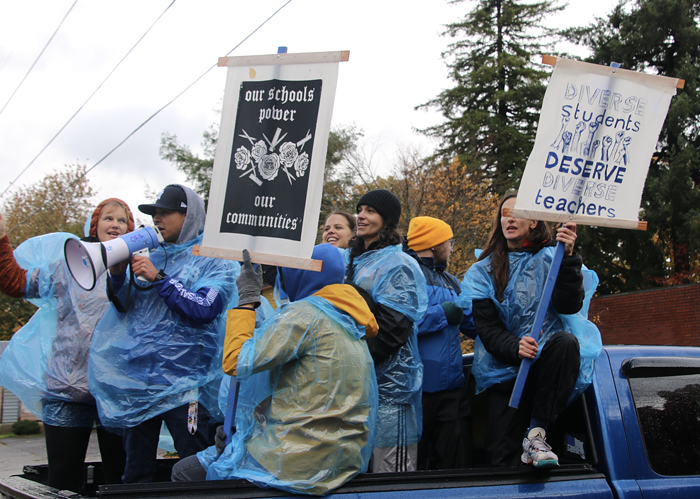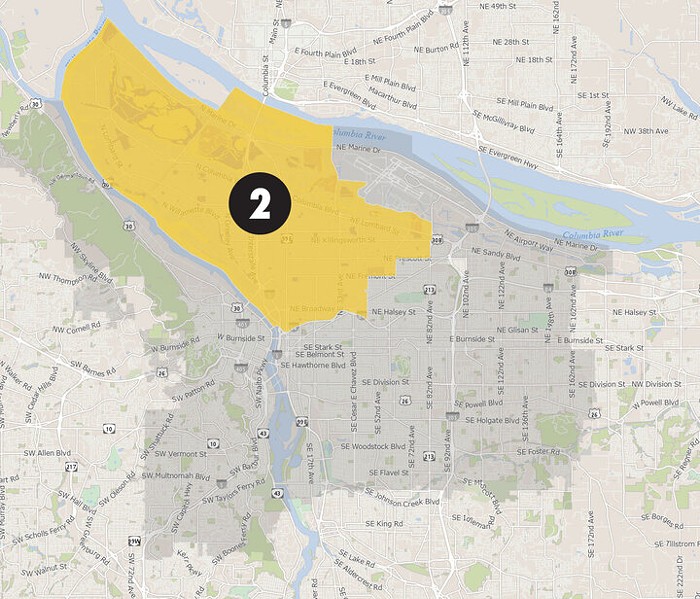
In the early hours of July 25, Mac Smiff was standing in Lownsdale Square, tweeting a photo of the protests, when he was shot in the head with a “less lethal” indelible paintball fired by a federal officer.
“I felt a bang on the right side of my forehead, and I was on the ground,” says the activist and We Out Here Magazine founder, who later tweeted photos of the injury. “They fired on me from… 15 to 20 yards away. There wasn’t anyone within 10 feet of me.”
Smiff is just one of many Portlanders who have been hit in the head by sponge rounds, pepper balls, flash bangs, or other crowd-control munitions fired by law enforcement officers in the past two months. In perhaps the most well-known incident, a member of the US Marshals shot protester Donavan La Bella in the forehead with an impact munition, resulting in a skull fracture and some loss of cognitive function. (La Bella was unarmed and holding a boombox.) A recent Oregonian article profiled several other people wounded by federal officers, including a photographer hit in the eye with pepper balls, a protester with metal shrapnel in his head from munitions, and a “Wall of Moms” member hit above the eye.
These injuries are particularly concerning because, according to the manufacturers’ instructions, officers should aim munitions at a person’s legs or buttocks.
“You are never ever allowed to shoot someone in the head with ‘less than lethal’ munitions,” says Travis Rainey, a former federal police officer and combat veteran who has been following the Portland protests. “There is a chart that designates ‘green areas’ which are where you aim and the distance you must maintain. It is stressed over and over that you never shoot at the head or groin area.”
Portland Police Bureau (PPB)’s own policies state that officers should make “reasonable efforts” to ensure that impact munitions are aimed below the waistline and away from the groin, specifying that officers “shall not deliberately target a subject’s head, neck, throat, or groin area, unless deadly force is authorized.” Despite this, PPB officers also have a documented history of hitting protesters in the head with munitions—and not only in the past two months of protests. In one 2018 incident, Portlander Aaron Cantu sued PPB after an officer’s flash-bang grenade lodged into his skull, blazing through his bike helmet.
Although protest attendees often wear bicycle or skateboard helmets as protective equipment, they may not provide adequate protection.
“A bicycle helmet is really designed for the impact that one would sustain in a bicycle accident,” says H. E. Hinson, a neurointensivist at OHSU. “They weren’t designed to avoid munitions.”
Hinson, who studies traumatic brain injuries, says it can be difficult for a layperson to judge the severity of a head injury. She encourages people hit by munitions to seek medical care if they experience headaches, confusion, sleep or mood disturbances, balance issues, or loss of consciousness. But seeing a doctor isn’t a realistic option for people like Jasper Florence, who has been covering the protests on Twitter since early July.
“The first night I got [hit in the head with pepper balls], it gave me a low level concussion,” says Florence. “I had massive brain fog for the rest of the week, but I kept going out. I didn’t go to the doctor because I don’t have health insurance. It was just like, take some Tylenol and deal with it.”
Smiff also suffered a concussion when he was shot on July 25. After a couple days off, he was right back at the protests. “I’m wearing a lot more armor now because you see folks getting injured every day,” he says.
Both Smiff and Florence identify themselves as media when at protests with helmets reading “PRESS.” Both believe that they were explicitly targeted by officers for documenting the protests, despite recent court orders barring officers from assaulting or threatening journalists.
“A lot of the instances where I have been shot, I have been out of the way or at the front of the line, so there is decent space between me and the protesters,” says Florence, who is Korean and nonbinary. “I’m definitely being targeted, probably because I’m one, press, and two, visibly queer under all of my armor. They’re targeting Indigenous and Black people, or anyone who is not a cis white guy.”
With state police replacing federal officers at the downtown protests, many Portlanders are left wondering whether there will now be less police brutality at the nightly police brutality protests. Smiff suspects that state and local police will be less aggressive with munitions than the feds, joking that the protests might return to “semi-normal levels of [police] violence.” But Florence is less optimistic, pointing out that local police were firing pepper balls and foam-tipped bullets at people well before federal officers arrived.
“The problem is not solved,” says Florence. “It’s just more cops—more chances to get shot in the head.”


















